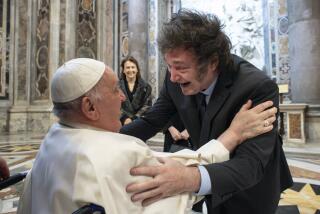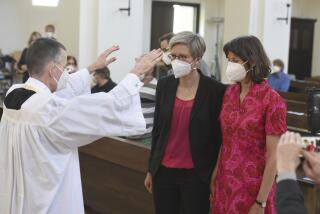Canonization ceremony by pope will be a first for U.S., and it’s a controversial one

WASHINGTON — Pope Francis’ decision to name Father Junipero Serra a saint has attracted contentious debate over the 18th century missionary’s methods in bringing Christianity to California and the West. But the actual moment of canonization will mark another milestone in American Catholic history: the first time a pope will perform the ceremony on U.S. soil.
It builds on a tradition started by Pope John Paul II in the 1980s, when the pontiff began leaving the Vatican to hold special canonization ceremonies in Seoul, Mexico City and Krakow, Poland, among other destinations. Recognizing saints on their home turf not only excited local Catholics, but it also fit into a larger philosophy of globalizing the church.
“Francis may be following the lead of John Paul II, but the practice of canonizing saints outside of Rome also supports his vision of the church, a church that meets people where they are,” said Kathleen Sprows Cummings, director of Cushwa Center for the Study of American Catholicism at the University of Notre Dame.
The ceremony is planned for Sept. 23, during Francis’ busy visit to Washington, D.C., his first Mass on U.S. soil at the Basilica of the National Shrine of the Immaculate Conception. The church, constructed in the 20th century in an attempt to rival the grand Renaissance cathedrals of Europe, is the largest Catholic church in North America and one of the 10 largest in the world. It is considered the nation’s Catholic church.
Francis plans to deliver the Mass in Spanish, his native tongue, with English translations on large screens, said Cardinal Donald Wuerl, the archbishop of Washington, who spoke with reporters this month about the visit.
Wuerl said the use of Spanish will carry symbolic value: a recognition of the nation’s growing Latino population; a reminder that Francis, a native of Argentina, is the first pope from the New World; and a nod to Serra, a Spaniard sent to California in 1769 to spread the gospel. Serra died in 1784 and is buried at Mission San Carlos Borromeo in Carmel.
“This is the big story: The first Hispanic pope is coming to America to give us our first Hispanic saint,” Los Angeles Archbishop Jose Gomez told reporters at a religion conference in August. “The pope is calling all of us in America to reflect on our history and our nation’s Hispanic and Catholic heritage and our legacy as a nation of immigrants.”
Scholars say they believe Francis wanted to name a saint during his visit here — celebrating the nation’s role in modern Catholicism — and may not even have been aware of the intense and long-standing controversy surrounding Serra when he announced in January that Serra would be canonized. Cummings said several other candidates for sainthood — including 19th century missionary Francis Xavier Seelos — might have been less controversial.
According to the U.S. Conference of Catholic Bishops, Serra will be the 11th saint with connections to the United States, including those who lived here before the nation’s founding.
Serra founded nine of California’s 21 missions as a leader of the Franciscan order. Many Native Americans have protested his sainthood because the Spanish flogged those who disobeyed and captured those who tried to leave the missions, while bringing diseases that devastated the indigenous population. A resolution in the California Legislature to replace a Serra statue in the U.S. Capitol with one of astronaut Sally Ride was pulled in July to avoid further controversy during the pope’s visit.
NEWSLETTER: Get the day’s top headlines from Times Editor Davan Maharaj >>
Serra’s defenders argue that he must be viewed in the context of his era and that he made several efforts to protect native peoples. For example, he demanded the removal of a comandante who failed to crack down on soldiers who raped local women, said Gregory Orfalea, a Serra biographer who plans to attend the canonization.
“I think Francis has picked him, not because he’s simple, because he’ll speak to those of us who have fallen and need to be picked up, and that his goodness, which is manifest once you study him, is therefore more meaningful,” Orfalea said.
Gomez acknowledged “the reality of colonization,” but said Serra was a wonderful and holy man. Abuses happened, he said, but Pope John Paul II publicly apologized for them years ago.
At least one of Serra’s critics does not expect many protesters to attend the event in Washington.
“I’m not going to travel 3,000 miles to complain against a guy who’s long dead,” said Ron Andrade, executive director of the Los Angeles City/County Native American Indian Commission. Andrade said his research shows Serra turned his head as soldiers committed rapes and murders.
“Our history with the church has been, even though we say, ‘This is wrong, don’t do this,’ they just say, ‘The hell with you,’” Andrade said.
But several scholars expect Francis will not dodge the controversy during the Mass and will refer to it, at least indirectly.
“I would not be surprised at all if, during the canonization process, he also makes note that the church was not perfect, could have been better in terms of how it acted,” said the Rev. Thomas Reese, a Jesuit who is a senior analyst for the National Catholic Reporter and the author of “Inside the Vatican: The Politics and Organization of the Catholic Church.”
During a trip to Bolivia in July, Francis built upon an apology delivered decades earlier by John Paul II. “I humbly ask forgiveness,” Francis said, “not only for the offenses of the church herself, but also for crimes committed against the native peoples during the so-called conquest of America.”
Twitter: @noahbierman
Times staff writer Sarah Parvini contributed to this report.
More to Read
Sign up for Essential California
The most important California stories and recommendations in your inbox every morning.
You may occasionally receive promotional content from the Los Angeles Times.











